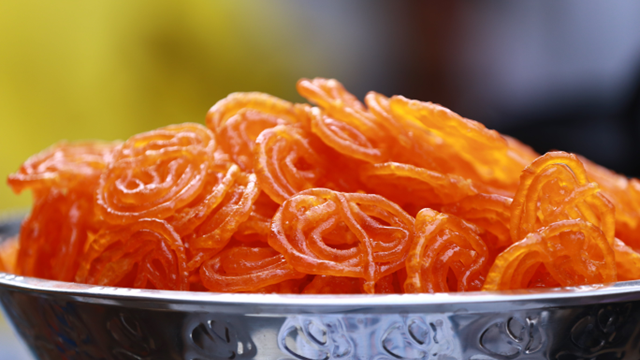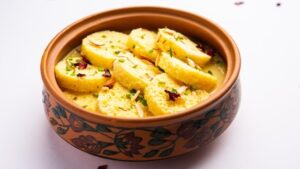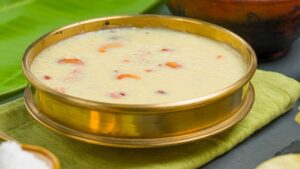Jalebi is a popular sweet dessert originating from the Indian subcontinent. It is made by deep-frying a wheat flour batter in pretzel or circular shapes, which are then soaked in sugar syrup. The resulting jalebis are crispy on the outside, with a somewhat chewy texture and a syrupy sweetness.
To prepare jalebi, a batter is made from all-purpose flour (maida), yogurt, and water, which is fermented for several hours to develop a slightly sour taste. This batter is then poured into hot oil or ghee in circular motions to create the distinct spiral or pretzel-like shape. Once fried to a golden color, the jalebis are dipped in a fragrant sugar syrup flavored with cardamom, saffron, or rose water, allowing them to absorb the syrup and imparting a sweet, aromatic taste.
Jalebi is often enjoyed as a dessert or snack, particularly during festivals, celebrations, and special occasions throughout India and neighboring countries. It is served warm or at room temperature and can be eaten on its own or paired with milk, yogurt, or rabri (sweetened condensed milk) to complement its sugary taste.
Variations
There are several variations of jalebi found across different regions, each with its own unique twist on this beloved sweet treat. Here are a few:

Imarti:
This variation is popular in Northern India. Imarti is quite similar to jalebi but has a slightly different shape. It’s made using urad dal (black gram) batter and has a thicker, more intricate design compared to regular jalebi.

Paneer Jalebi
Paneer (Indian cottage cheese) jalebi is a richer version where paneer is added to the batter, giving it a unique taste and texture. This variation is especially popular in parts of Rajasthan.

Mawa Jalebi:
Mawa, or khoya (reduced milk solids), is added to the batter in this variation, giving the jalebi a richer, creamier taste. It’s often found in sweet shops in parts of Gujarat and Rajasthan.

Rabri Jalebi:
Jalebi is served with rabri, a sweet, condensed milk-based dessert. The combination of hot jalebi with cold rabri creates a delightful contrast in temperatures and flavors.

Saffron Jalebi:
Saffron-infused batter gives these jalebis a distinct aroma and a beautiful golden color. Saffron jalebis are often served during festivals and special occasions.
Regional Flavors:
Different regions might incorporate local flavors into their jalebis. For instance, in some places, cardamom or rose water might be added to the sugar syrup for a unique aromatic touch.
Size and Shape:
While the classic jalebi is typically circular or spiral-shaped, variations in size and shape exist. Some jalebi might be larger, smaller, thicker, or even presented in different geometric patterns.
These variations showcase the diverse ways in which jalebi is prepared and enjoyed across India and neighboring countries. Each variation adds its own distinct flavor and texture, making jalebi a versatile and cherished dessert with regional nuances.
Ingredients:
The ingredients used in making jalebi typically include:
- All-Purpose Flour (Maida): The main base for the batter used to make jalebi.
- Yogurt: Adds a slight tanginess to the batter and aids in fermentation, which helps in achieving the characteristic texture and taste of jalebi.
- Baking Soda or Yeast: Used as a leavening agent to help the batter rise and ferment, giving the jalebi its spongy texture.
- Sugar: Used in both the batter and the sugar syrup to sweeten the jalebi.
- Water: To make the batter and the sugar syrup.
- Saffron or Food Coloring: Often added to the batter to give the jalebi its signature golden color. Saffron also adds a distinct aroma and flavor.
- Oil or Ghee (clarified butter): Used for deep-frying the jalebi. Ghee is sometimes preferred for its rich flavor.
For the sugar syrup:
- Sugar: Used to make the syrup that the jalebi is soaked in after frying.
- Water: To dissolve the sugar and create the syrup.
- Cardamom, Saffron, or Rose Water: Flavorings added to the sugar syrup for a fragrant and aromatic touch. Cardamom seeds, saffron strands, or rose water are commonly used to infuse the syrup with a delightful aroma.
These ingredients form the basic components required to prepare jalebi. Variations in recipes might involve additional elements like semolina (sooji), gram flour (besan), paneer, mawa (khoya), or other regional flavors and ingredients that give unique textures and tastes to specific types of jalebi.
Cultural Significance:
Jalebi holds significant cultural importance, especially in South Asian countries like India, Pakistan, Bangladesh, and Nepal. Here are some aspects of its cultural significance:
- Festivals and Celebrations: Jalebi is a popular treat during various festivals and celebrations. It is commonly prepared and consumed during major festivals like Diwali, Holi, Eid, Raksha Bandhan, Navratri, and weddings. Its presence symbolizes joy, happiness, and celebration during these auspicious occasions.
- Traditional Cuisine: Jalebi is deeply rooted in the culinary traditions of South Asia. Its preparation and consumption have been passed down through generations, making it an integral part of the region’s cuisine.
- Symbol of Sweetness: Jalebi’s sweetness symbolizes the sweetness of life and is often used in festivals and rituals to offer prayers and blessings for a prosperous and happy life ahead.
- Street Food and Social Gatherings: Jalebi is commonly sold as a popular street food item across India and neighboring countries. Street vendors prepare them fresh, attracting locals and tourists alike. It serves as a social snack, bringing people together over its delectable taste.
- Ceremonial Offerings: In some traditions, jalebi is offered in temples and during religious ceremonies as prasad (an offering to the deity) or as part of traditional rituals to seek blessings.
- Regional Variations and Identity: Different regions have their own variations of jalebi, showcasing the diverse culinary heritage of South Asia. These regional varieties are cherished and contribute to the cultural identity of specific areas.
- Hospitality and Generosity: Jalebi, along with other sweets, is often served to guests as a gesture of hospitality and warmth. It’s considered a way of showing respect and treating guests with honor.
Overall, jalebi is more than just a sweet dish; it embodies cultural traditions, festivities, and acts as a symbol of togetherness and celebration in various social and religious contexts throughout South Asia.
Global Popularity
Jalebi, the iconic sweet from South Asia, has gained significant popularity beyond its region of origin and has become recognized and appreciated worldwide. Here’s an overview of its global popularity:
- Presence in Indian Restaurants: Jalebi is commonly featured on the dessert menus of Indian restaurants across the globe. Its unique taste and distinct appearance make it a sought-after sweet dish among patrons looking to explore Indian cuisine.
- International Food Fairs and Festivals: Jalebi often makes an appearance at international food fairs, cultural festivals, and culinary events, where it is showcased as a representative of Indian sweets. Its eye-catching appearance and delightful taste attract people eager to experience diverse global cuisines.
- Adaptation in Fusion Desserts: Chefs and food enthusiasts worldwide experiment with jalebi, incorporating it into fusion desserts or adapting its flavors into innovative creations. It might be used as a topping for ice creams, paired with other international sweets, or featured in fusion recipes that blend various culinary influences.
- Social Media and Culinary Influence: The visually appealing and vibrant appearance of jalebi has made it a popular subject on social media platforms. Food bloggers, influencers, and culinary enthusiasts share recipes, photos, and videos of jalebi, contributing to its exposure and popularity among global audiences.
- Integration into Local Palates: In certain regions, jalebi has been embraced and adapted to suit local tastes. Chefs and cooks have modified recipes or incorporated jalebi-making techniques into their culinary repertoire, making it more accessible and appealing to a wider audience.
- Tourism and Cultural Experiences: For travelers visiting South Asia or Indian cultural festivals abroad, jalebi often serves as a must-try dessert, offering a taste of authentic regional cuisine and a cultural experience.
- Availability in Ethnic Stores: Jalebi, along with other Indian sweets, is often available in ethnic grocery stores or specialty food shops catering to diverse communities worldwide. This availability allows individuals from various backgrounds to enjoy and appreciate this traditional Indian dessert.
The global popularity of jalebi signifies its acceptance and appreciation beyond its cultural origins, showcasing its appeal as a beloved sweet treat enjoyed by people from different parts of the world.
Serving and Presentation:
The serving and presentation of jalebi involve certain traditional practices and variations, adding to its appeal and enjoyment. Here’s how jalebi is typically served and presented:
- Warm or Room Temperature: Jalebi is often served warm or at room temperature, depending on personal preferences. When served warm, it retains its crispiness and allows the sugar syrup to be slightly more liquid, enhancing its sweetness.
- Presentation Style: Jalebi is commonly presented stacked or arranged in circular patterns on plates or serving trays. Its vibrant golden color and intricate spiral or coil shapes make it visually appealing.
- Accompaniments: While jalebi can be enjoyed on its own, it is sometimes served with accompaniments that complement its flavors. One popular combination is “jalebi with rabri,” where the hot jalebi is paired with cold, thickened sweetened milk (rabri), creating a contrast of temperatures and textures.
- Garnishes: Some variations may include garnishing the jalebi with chopped nuts like pistachios, almonds, or cashews to add a contrasting texture and enhance its visual appeal. This is more common in certain preparations or when serving jalebi with accompaniments.
- Packaging and Street Food Presentation: In street food settings or takeaway orders, jalebi is often served in paper cones or plates lined with banana leaves or parchment paper. This convenient packaging retains its warmth and prevents the syrup from spilling while making it easy to enjoy on-the-go.
- Festive and Occasional Decorations: During festivals and special occasions, jalebi might be presented on decorative plates or trays adorned with flowers, colorful decorations, or traditional elements, enhancing its festive significance.
- Quantity and Portioning: Depending on the occasion and setting, jalebi is served in varying quantities – from individual servings to larger platters for sharing at social gatherings, weddings, or festivals.
The presentation of jalebi not only focuses on its delightful taste but also on its aesthetic appeal, ensuring an enjoyable sensory experience. Whether served at home, in restaurants, or as a street food, the visual appeal and traditional serving styles contribute to the overall charm of enjoying this beloved dessert.
Street Food Delight
Jalebi is an immensely popular and cherished street food across many parts of India and neighboring countries. Here’s why it’s considered a delightful street food:
- Freshly Prepared: Street vendors often prepare jalebi on-site, ensuring that customers get to enjoy them fresh and hot. The enticing aroma of frying batter and sugar syrup draws people to these street stalls.
- Spectacular Preparation: The process of making jalebi involves skillful techniques where the batter is squeezed into hot oil in circular motions, resulting in intricate coil shapes. Watching the jalebis being made right in front of you is part of the experience.
- Engaging Street Food Culture: Jalebi stalls are an integral part of the vibrant street food culture in many cities and towns. These stalls often attract locals and tourists alike, creating a lively atmosphere around the preparation and enjoyment of this sweet treat.
- Affordability and Accessibility: Jalebi is a relatively inexpensive snack, making it accessible to a wide range of people. Its affordability ensures that it remains a popular choice among various social and economic demographics.
- Variety and Combinations: Street vendors might offer variations of jalebi, such as different sizes or slightly varying tastes. Additionally, jalebi is often paired with other street snacks like samosas, kachoris, or served alongside hot milk or chai (tea), offering diverse taste experiences.
- Quick and Convenient: Jalebi is a quick snack option, perfect for those looking for a sweet treat on-the-go. Its convenient packaging in paper cones or plates makes it easy to carry while exploring bustling streets or markets.
- Nostalgia and Tradition: Many people associate jalebi with childhood memories or festive celebrations. Its presence as a street food item evokes nostalgia and a sense of tradition, contributing to its popularity and demand among locals and visitors.
- Community and Socializing: Street food stalls often serve as meeting points for locals, where people gather to chat, share stories, and bond over a common love for delicious snacks like jalebi, fostering a sense of community.
The combination of its delectable taste, visual appeal, affordability, and the lively atmosphere surrounding its preparation makes jalebi a beloved and cherished street food that adds vibrancy to the culinary landscape of many regions.




